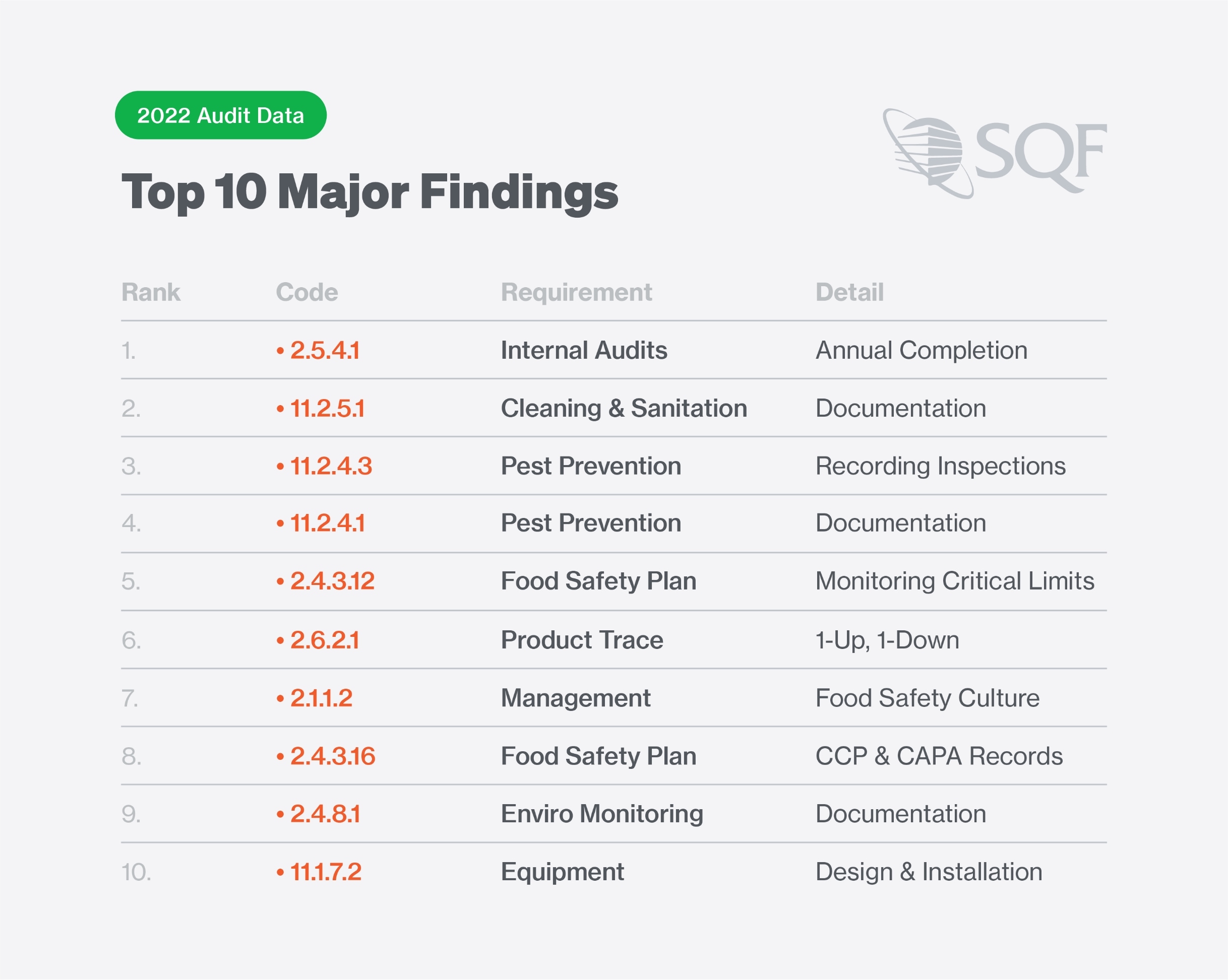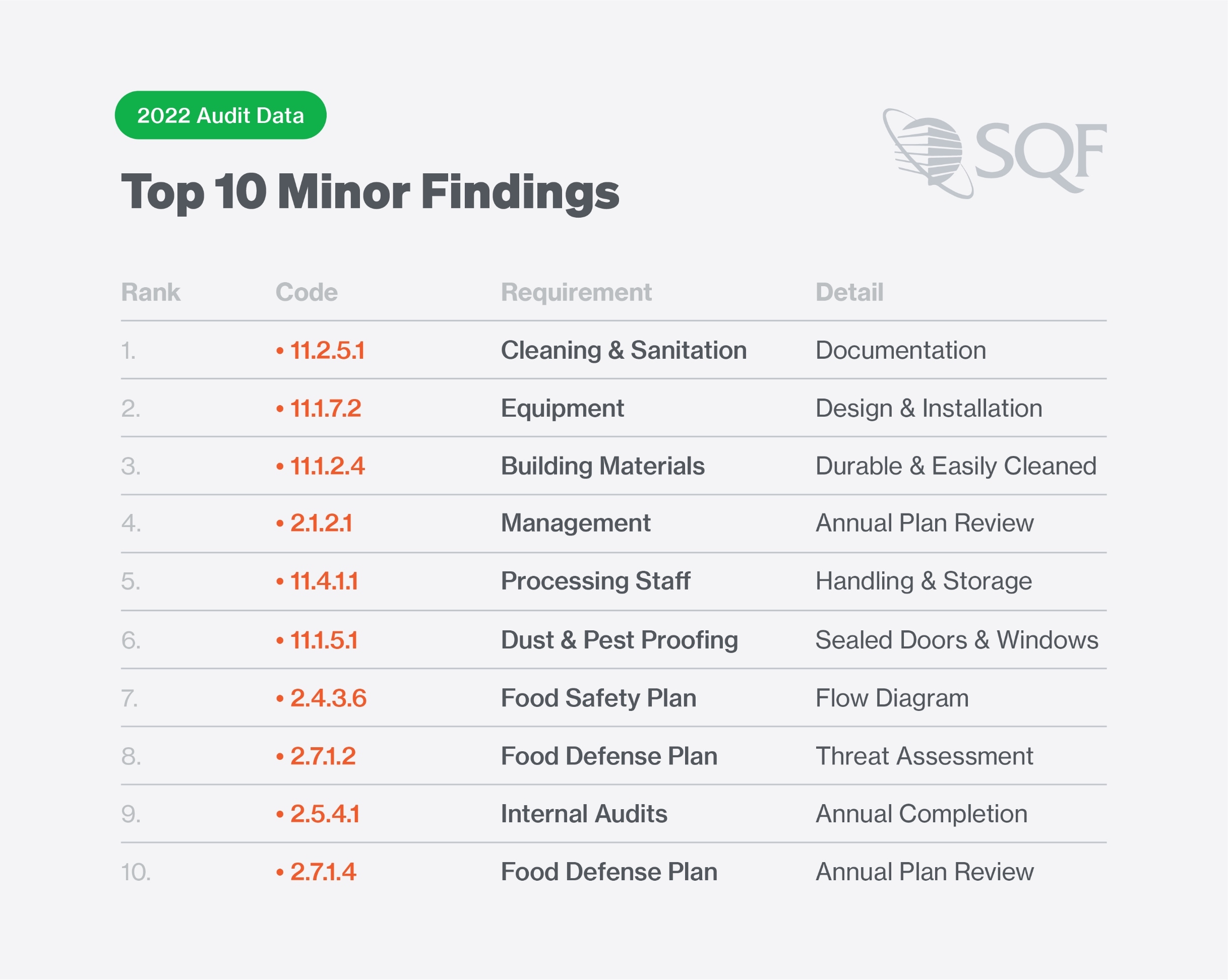How to Control Risk for the Top Findings in SQF Audits
An inside look at critical, major, and minor non-conformances – and how to safeguard your operation using smarter tools.
Chapters
The Significance of SQF Audits
SQF (Safe Quality Food) audits stand as a cornerstone for ensuring that food products meet the highest standards of food safety and quality assurance. Among the most recognizable certification schemes around the world, SQF audits are pivotal for maintaining consumer trust, regulatory compliance, and industry credibility.Audits go beyond mere compliance; they provide an opportunity for organizations to identify areas of improvement within their food safety management systems in order to anticipate and prevent future failures and improve efficiencies. Non-conformances, or “findings” - areas where an auditor identifies that the site has not fulfilled requirements of the SQF code - offer insights that drive continuous enhancement and innovation.
The Top 10 Findings in SQF Audits
In 2022, approximately 12,000 SQF audits were conducted worldwide, uncovering the most common non-conformances across critical, major, and minor categories.


Five Key Learnings from the Findings
1.
Pest Documentation Is Easily Overlooked
The prevalence of pest-related non-conformances underscores the persistent challenges in maintaining pest-free food production environments. With the added influence of changing climate trends that may allow pests to spread to new areas of the globe, staying one step ahead is crucial.
While many facilities may be clear of pests, their documentation is a recurrent issue. Records from third-party service providers are often missing, unverified, or incomplete when compared to a facility’s food safety plan. The presence of pests must trigger product disposal and corrective action, with evidence, in certain circumstances. These steps can protect not only audit results, but also brand reputations.

“Cleaning, sanitation, and pest prevention have always been in the top three major and minor non-conformances going back to 2018. These are areas that really need focus.”
Tammie Van Buren • Compliance Manager, SQFI
2.
Internal Audits Are Crucial
Many SQF sites accumulate findings by missing internal audits, or by lacking sufficient evidence of root cause and CAPA to resolve findings from their internal audits. This lack of investment has broader consequences; it may cause management to miss opportunities in other elements of a food safety plan, leading to poorer performance in SQF audits overall.

“Sites with a minor non-conformance in their internal audit program score an average of five points lower than a site without that non-conformance. Sites with a major finding in their internal audit program score an average of 25 points lower. Without a strong internal audit program, the overall system does poorly.”
Tammie Van Buren • Compliance Manager, SQFI
3.
CCP and Critical Limit Systems Need Better Monitoring
While some food safety plans are not robust in identifying critical control points (CCPs), most SQF sites are simply challenged with missing CCP records and proof of monitoring. Food safety managers who manually read through high volumes of paper submissions may also run late in detecting and addressing breaches of their critical limits — or the deviations may be missed entirely and uncovered in their SQF audits.

“The SQF code requires documented evidence for conformance as well as non-conformance in critical limits. It’s the proof of compliance that is often missed.”
Tammie Van Buren • Compliance Manager, SQFI
4.
CAPA Is Regularly Mismanaged
Corrective and preventive action (“CAPA”) management can suffer from incomplete follow-up or shallow root cause analysis. It’s all too common to see the symptoms of a problem being treated for temporary relief rather than diagnosing the true issue. For example, a hose left on the floor may be put away, but the real issue is that the hose reel may be on the wrong side of the production line. It’s critical that CAPA be designed and implemented in a way that prevents recurrence.

“Sixteen elements within the SQF code mention root cause analysis or corrective and preventive action. It’s a significant focus in audits, and therefore, a significant improvement opportunity for most companies.”
Tammie Van Buren • Compliance Manager, SQFI
5.
Leaders Must Buy Into Food Safety Culture
Management disconnect remains a powerful driver when it comes to audit findings in food safety culture. Annual reviews are often weak or missing, and leaders’ involvement can remain too isolated from what’s happening day-to-day in production settings.

“If a site is doing an annual test, but every year they use a fire as the scenario for their crisis management system – then are they really getting a good measure of their system, or do they just know how to handle a fire? Food safety culture requires more dynamic leadership.”
Tammie Van Buren • Compliance Manager, SQFI
How to Mitigate Your Risk
1.
Pest Prevention
Limit missed monitoring activities, and consolidate image evidence with third-party records.
2.
Internal Audits
Adopt smart checklists that automate CAPA, scoring, and reporting for continuous improvement.
3.
CCP & Critical Limit Monitoring
Never miss another deviation with the help of smart rules that trigger customizable escalation.
4.
CAPA Management
Enable data-driven root cause analysis to prevent recurring issues.
5.
Food Safety Culture
Build a stronger food safety culture with better operator guidance and management insights.
The Path Forward
Non-conformances, while they may be initially discouraging, should not be viewed as setbacks. Rather, consider them stepping stones in improving your organization’s food safety system. Taken as an opportunity to evolve, the areas identified as weak or noncompliant should be welcomed.

“Sites must focus on root cause analysis with corrective and preventive action to achieve sustainable success in their food safety management.”
Tammie Van Buren • Compliance Manager, SQFI
SQF-certified sites are increasingly leveraging technology to improve their response time and prevention for the common findings identified in this article. Smarter daily controls are limiting stress for food safety managers heading into audits. Provision clients currently report an average 62% time savings in audit preparation after adopting the platform. This highly efficient preparation shows that the food safety managers feel audit-ready on an ongoing basis. As unannounced audits become more common, it is becoming more and more important for SQF-certified sites to have these systems in play.


“Sites must focus on root cause analysis with corrective and preventive action to achieve sustainable success in their food safety management.”
Tammie Van Buren • Compliance Manager, SQFI

“Sites must focus on root cause analysis with corrective and preventive action to achieve sustainable success in their food safety management.”
Tammie Van Buren • Compliance Manager, SQFI
Ultimately, easy audit preparation and limited audit findings are just two symptoms of strong food safety systems. When companies use documentation to create data-driven insight, their real advantage is a food safety culture that is capable of controlling and continuously improving process results.



